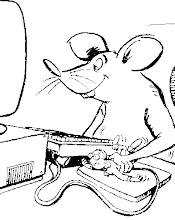Firstly I'll compare and contrast the two Ms in terms of the system. One is above RSI 70 and is formed when the Bollinger bands are wide apart. The other is just above 60 and is formed when the Bollinger bands are close together. They are both "fallers" - the first one only just.They both are OK in terms of Price action /Bollinger. The first is tradeable, the second is NOT!!! Why not? Answer comes later on.

[I feel that both clearly come at the ends of EWT waves. The first one at the end of a trender, the second at the end of a corrective. I already "feel" that correctives can be gentle or sharp, this was a gentle one. The Bollinger bands signal what has gone on before, the Ms the end of waves.]
[Now some real problems for my system!]
Because the corrective went above the B/E for the first M, I'd have been stopped out on my backstop. The only way I could have survived is to keep some back at the original S/L.
[My best WMs, in terms of meeting the rules, come at the end of trends, so am I just trading the correctives? IF it's a sharp one then bingo but if it's a gentle one I only get my "0.5(20+0)" sort of return.Should that concern me, still making money?]
[Some of my best WMs in terms of return have been the taking out of a previously verified R/S level, the infamous "failed WMs etc....". So that's a real bonus, the system indentifies a corrective, which then fails, so it leads to a motive.....]
[The second M was not a system trade, fails the Price/Bollinger reward:risk check. If it's a gentle corrective then the Bollinger bands must be narrow but that doesn't mean the next motive won't be a real trender.]
So in a nutshell, the reward:risk rule is working both for and against me. It filters out those WMs generated by market noise BUT it also keeps me out of those at the end of gentle correctives which MIGHT lead to a really big move.
I need time to think + would welcome any thoughts from practised EWTers.
The next image shows a wW which is uncommon.
[Signalled the end of the powerful wave 3? The subsequent move back up to the region of a standard Fib level(not on image) seems to confirm that.]

---------------------------------------------------------------------------------
Finally, for those who like 1-2-3 trades on Price, this was the set up that coincided with my 60 min M that was NOT a system trade - maybe that is something that needs looking at?

cheers theory







